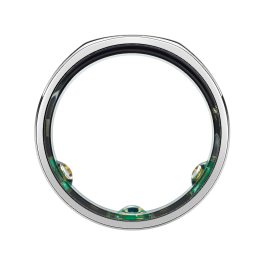- Cycle syncing is a practice in which you align your daily habits to better support your body during each phase of your menstrual cycle.
- Small adjustments in your sleep habits, exercise, or nutrition may help you feel more balanced and energetic throughout your cycle.
- Oura’s Cycle Insights feature empowers you to learn where you are in your cycle and offers tailored insights to align your habits with your cycle phase.
If you track your menstrual cycle using Oura’s Cycle Insights, you may have noticed some patterns emerge throughout the month.
Perhaps you feel extra-energized mid-cycle, but you only want to Netflix-and-chill during your luteal phase. Or maybe you crave sweets during menstruation, while you go for other foods during your follicular phase.
The reason why: During your cycle, your sex hormones, including progesterone, estrogen, and luteinizing hormone, rise and fall. The fluctuating hormonal levels can cause your body to send out varying signals, which may appear as changes in appetite, energy, mood, or could lead to other symptoms such as bloating.
One way to better manage these changes is a concept called cycle syncing.
LEARN MORE: How Your Menstrual Cycle Impacts Your Entire Body
What Is Cycle Syncing?
Adjusting your routines around the phases of your menstrual cycle to feel more balanced and energized is known as cycle syncing. On social media platforms like TikTok, where the hashtag has over 475 million views (!), it’s become an increasingly popular topic — though it’s important to note that the research behind it is still emerging.
“Syncing your habits and routines to your cycle is highly personal,” says Dr. Christine Noa Sterling, MD, board-certified OB-GYN and Oura medical advisor. “What feels good and is right for one person during a particular phase of their cycle isn’t necessarily right for another. If it works for you, fantastic! But it’s not necessary.”
“Not everyone experiences the same changes throughout the month, as each person is unique,” explains Sari Eitches, MD, an internist who specializes in women’s wellness. “Some people are more sensitive to their hormonal changes than others,”
People on hormonal birth control typically do not experience hormonal fluctuations, as the synthetic hormones override your natural hormones, so may experience less benefit from cycle syncing.
Potential Benefits of Cycle Syncing
For some people who menstruate, cycle syncing may offer a path to relief from symptoms that range from uncomfortable (like bloating or fatigue) to painful (such as cramps or migraines). According to Cleveland Clinic, cycle syncing may help to decrease period symptoms, balance hormones in people with polycystic ovary syndrome (PCOS), improve your mood, lower stress, and reduce premenstrual syndrome (PMS).
As Eitches notes, “Cycle syncing is about supporting your body through these periods of hormonal change, so you’re working with your biology, rather than against it.”
At its core, cycle syncing doesn’t have to be extremely prescriptive or involve major changes to your lifestyle. Eitches says: “It’s about recognizing patterns between your changing hormone levels and your symptoms, so you can feel empowered to give your body what it needs to feel your best.”
LEARN MORE: Oura’s Cycle Insights
Using Oura to Track Your Cycle
Using Oura can help you establish these patterns in order to connect with your body and build habits that support your hormonal health. With Cycle Insights, you can identify which phase of your menstrual cycle you’re in — follicular or luteal. You’ll get daily insights to learn how your cycle phase impacts your body, to help you adjust your sleep, nutrition, movement, or habits to support your body throughout each cycle phase.
Below, learn more about what you may expect in each phase of your cycle, and tips to mitigate symptoms of each. “Keep in mind that every individual is different, and you may not experience the same symptoms or signs as someone else,” Dr. Sterling notes.
LEARN MORE: How to Align Your Movement With Your Menstrual Cycle
1. Menstruation
Menstruation begins on day 1 of your cycle, and is marked by your period start.
Overall Mood
- You may experience mood swings or feel more irritable.
- You may have low back pain, abdominal cramping, or pelvic pain.
- You may feel more fatigued or experience bloating.
- You may experience lower endurance during exercise.
Sleep
“You may find it harder to get comfortable on your period, which can impact your sleep quality as you find yourself tossing and turning,” Eitches says. (You can track this with Oura using the Nighttime Movement Graph.) This can be due to menstrual cramps, a heavy flow that requires changing your care product during the night, or overall increased sensitivity to pain.
Additionally, your levels of estrogen and progesterone are at their lowest, which is linked to less REM sleep. You also may find it takes longer to fall asleep (which you may see in your latency contributor to your Oura Sleep Score), you wake up more frequently during the night, or sleep less overall.
To sleep better during your period, try these tips, recommended by Sterling:
- Make sure your period care products are comfortable. If possible, use a product that allows you to sleep through the night without having to change or empty the product.
- Start winding down for bed about one to two hours before you hope to fall asleep. Allowing time for quiet and relaxation is key to giving your mind and body a chance to unwind and prepare for sleep.
- It’s important to stay hydrated during menstruation, but try to avoid drinking water less than two hours before bedtime. Otherwise, you might find yourself waking up to use the restroom one to two hours after falling asleep.
READ MORE: Tired During Your Period? 5 Potential Reasons Why
Nutrition
During your period, you may feel more hungry and have distinct food cravings. To offset painful cramps, muscle tension, or bloating, here are some foods to consider adding to your diet as you menstruate.
- Iron, calcium, and magnesium-rich foods, found in sources like lean meat, fish, and legumes, can help improve iron levels that are depleted from blood loss during menstruation. Pro tip: Combine your iron-rich foods with vitamin C to help with absorption.
- Include sources of calcium (good sources include dairy products and dark leafy greens) and magnesium (found in nuts, seeds, and dark chocolate) in your diet. These nutrients may help to alleviate muscle tension and menstrual cramps.
- Go for omega-3 fatty acids, found in foods such as fatty fish (salmon, mackerel, and sardines), flaxseeds, chia seeds, and walnuts. These anti-inflammatory powerhouses can treat menstrual pain. One study found that omega-3 fish oil supplementation was more effective at treating menstrual pain than Ibuprofen.
- Limit caffeine, sugary foods, alcohol, and sodium, which can exacerbate symptoms like irritability, cramps, low energy, bloating, and mood swings.
2. Follicular Phase, Including Ovulation
The follicular phase starts on the first day of your period and typically lasts, on average, 14 days, ending in ovulation. However, it’s important to note that this is just an average. Aggregate data from 2,500 Oura members found that the typical number of days between period onset and ovulation for Oura members ranges from about 8 days up to 25 days.
READ MORE: Busting the 14-Day Ovulation Myth
Overall Mood
- You feel more energized and have an improved mood.
- You may experience increased strength and endurance during exercise.
- You may have increased libido, particularly around ovulation.
- You may report enhanced creativity and cognitive performance.
Sleep
In the follicular phase, you may enjoy an improvement in your sleep. Estrogen levels gradually rise, potentially contributing to increased REM sleep, which is associated with dreaming and cognitive processing. You also may get more deep sleep, promoting physical restoration and recovery.
Nutrition
In this phase, your metabolism tends to be lower, so you may experience less food cravings. Your estrogen levels rise to their highest point during this phase, up until ovulation. Opt for foods that clear excess estrogen from the body to maintain healthy estrogen levels.
- Go for low-GI (Glycemic Index) carbs, including whole grains, legumes, and non-starchy vegetables.
- Omega-three fatty acids, found in fatty fish, nuts (especially walnuts), flaxseeds, and leafy vegetables, can help support hormonal balance. It may also boost fertility by increasing oocytes (eggs) in the ovaries.
3. Luteal Phase
After ovulation, you enter your luteal phase. This continues from approximately day 14 until the end of your cycle, which on average, is 23-35 days. (The idea of a cycle lasting exactly 28 days is a myth!) This phase ends when you start your period and enter the follicular phase again.
Overall Mood
- You may experience a dip in your mood.
- You may feel physical and mental fatigue.
- You may experience a reduction in strength during exercise.
- You may feel more hungry than usual.
- You may have a decline in cognitive performance (trouble concentrating, poor memory recall.
Sleep
During the luteal phase, which occurs after ovulation, you may be more susceptible to sleeping disturbances. Your progesterone levels rise, estrogen is low, and in the late-luteal phase, PMS hits. Mood swings, daytime sleepiness, and a rising basal body temperature all contribute to a decrease in sleep quality and less REM sleep. In fact, women who experience PMS are twice as likely to experience insomnia.
The tips mentioned above in the Menstruation section can help improve your sleep during the luteal phase as well.
LEARN MORE: 5 Ways to Upgrade Your Sleep Hygiene
Nutrition
Research shows that the female metabolism may be faster during the luteal phase, accounting for around 200 more calories a day being burned. An increased metabolic rate can increase cravings and hunger and cause tiredness if you don’t get enough food. If you are cycle syncing, you may consider eating more during this phase to support this increase.
- Complex carbohydrates, like brown rice, lentils, or oats, can increase serotonin, which can help regulate your mood.
- The rise of progesterone in this phase has a relaxing effect on smooth muscles, like those in your intestines, which may result in slower bowel movements and a higher chance of constipation. Counteract this by eating plenty of fiber to keep things moving – think berries, broccoli, oatmeal, and avocados.
- Vitamin B6, found in poultry, fish, bananas, spinach, and chickpeas, plays a crucial role in the metabolism and synthesis of prostaglandins. Prostaglandins support the shedding of the uterine lining during menstruation, but excess prostaglandins cause painful cramps. This vitamin may also alleviate symptoms like breast tenderness and mood swings that can occur during the luteal phase.
Information + Action = Empowerment
Our goal at Oura is to empower you with information about your health so that you can take action to support your body and mind. If you’re a person with a menstrual cycle, know that you don’t need to cycle sync. If it seems to help — great. If it feels overwhelming — don’t worry. Small adjustments, listening to your body, and tracking your symptoms can be enough to make a big difference.
About the Oura Expert
Dr. Christine Noa Sterling is a board-certified ObGyn, mom-of-three, and founder of Sterling Parents, a membership that acts as a one-stop-shop to get your health questions answered, prepare for pregnancy, birth, breastfeeding, and taking care of your baby, all while centering your wellness and cultivating your unique parenting style.





